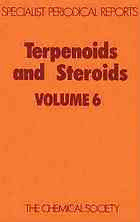Table Of ContentA Specialist Periodical Report
Terpenoids and Steroids
Volume 6
A Review of the Literature Published
between September 1974 and August 1975
Senior Reporter
K. H. Overton, Department of Chemistry,
University of Glasgow
Reporters
D. V. Banthorpe, University College, London
G. Britton, University of Liverpool
B. V. Charlwood, King's College, London
J. D. Connolly, University of Glasgow
N. Darby, University of British Columbia, Vancouver, Canada
J. R. Hanson, University of Sussex
0. N. Kirk, Westfield College, London
T. Money, University of British Columbia, Vancouver, Canada
P. J. Sykes, University of Edinburgh
J. S. Whitehurst, University of Exeter
R. B. Yeats, Bishop's University, Quebec, Canada
@ Copyright 1976
The Chemical Society
Burlington House, London, WIV OBN
ISBN: 0 85186 306 X
ISSN: 0300-5992
Library of Congress Catalog Card No. 74-615 720
Set in Times on Linotron and printed offset by
J. W. Arrowsmith Ltd., Bristol, England
Made in Great Britain
Introduction
Even a casual perusal of this volume will show that the health and vigour of terpenoid
and steroid chemistry have in no way declined since the first Report in this series
appeared in 1971. Nature continues to present us with the most unpredictable and
challenging structures constructed from mevalonate. The toxic diterpenoids from
Euphorbia species and the squalene-based Duphniphyllum alkaloids provide good
recent examples. As X-ray analysis provides an almost routine procedure for
unravelling even such complex structures, interest moves increasingly in the
directions of biosynthesis and laboratory synthesis with a fruitful interplay in the area
of biogenetically patterned synthesis. Characteristically, new instrumentation has
been exploited and extended to the full, the outstanding example being 13C n.m.r.
spectroscopy and particularly its use as a non-destructive method for establishing
labelling patterns in biosynthesis. Resourcefulness and ingenuity abound in meeting
aesthetic and commercial challenges in the field of synthesis.
As I hand over the task of Senior Reporter to my successor, Dr. J. R. Hanson, it is a
pleasure to record my gratitude to all the colleagues who have written these Reports
for their enthusiastic and unstinting collaboration.
K. H. OVERTON
Cont en
ts
Part I Terpenoids
Chapter 1 Monoterpenoids 3
By R. B. Yeats
1 Physical Measurements: Spectra efc.; Chirality 3
2 General Synthetic Reactions 6
3 Biogenesis, Occurrence, and Biological Activity 10
4 Acyclic Monoterpenoids 14
Terpenoid Synthesis from Isoprene 14
2,6-Dimethyloctanes 15
Halogenated Monoterpenoids 19
Artemisyl, Santolinyl, Lavandulyl, and Chrysanthernyl
Derivatives 20
5 Monocyclic Monoterpenoids 21
Cyclobutane 21
Cyclopentanes, Iridoids 23
pMent hanes 27
o-Menthanes 31
rn-Menthanes 32
Tetramethylcyclohexanes 32
Dimet hylethylcyclohexanes 33
Cycloh ep tanes 33
6 Bicyclic Monoterpenoids 35
Bicyclo[3,1, O]hexanes 35
Bicycle[ 2,2 ,1 1 heptanes 35
Bicyclo[3,l,l]heptanes 41
Bicyclo[4,170]heptanes 45
7 Furanoid and Pyranoid Monoterpenoids 47
8 Cannabinoida and other Phenolic Monoterpenoids 48
V
vi Terpenoids and Steroids
Chapter 2 Sesquiterpenoids 52
By N. Darbyand T. Money
1 Farnesanes 52
2 Bisabolanes 56
3 Sesquicarane 59
4 Sesquipinane (Bergamotane), Sesquifenchane,
Sesquicamphane, Santalane 60
5 Acorane, Carotane, Cedrane 61
6 Cuparane, Laurane, Trichothecane, Cyclotrichothecane 62
7 Chamigrane efc. 64
8 Amorphane, Cadinane, Copacamphane, Sativane, efc. 65
9 Himachalane, Longipinane, Longicamphane, Longifolane, 69
efc.
10 Humulane, Caryophyllane, Hirsutane, Protoilludane,
Illudane, Marasmane 71
11 Germacrane, Eudesmane, Vetispirane 75
12 Guaiane, Aromadendrane, Pseudoguaiane 88
13 Mono- and Bi-cyclofarnesanes 91
14 Miscellaneous 94
Chapter 3 Diterpenoids 96
ByJ. R. Hanson
1 Introduction 96
2 Bicyclic Diterpenoids 97
Labdanes 97
Clerodanes 99
3 Tricyclic Diterpenoids 100
Naturally Occurring Substances 100
The Chemistry of the Tricyclic Diterpenoids 102
4 Tetracyclic Diterpenoids 105
The Kaurene-Phyllocladene Series 105
Be yeranes 107
Gibberellins 109
Diterpenoid Alkaloids 111
Contents vii
5 Macrocyclic Diterpenoids and their Cyclization Products 112
115
6 Miscellaneous Diterpenoids
7 Diterpenoid Synthesis 116
118
Chapter 4 Triterpenoids
By J. D. Connolly
118
1 Squalene Group
2 Fusidane-Lanostane Group 120
3 Darnmarane-Euphane Group 123
Tetranortriterpenoids 126
Quassinoids 128
4 Shionane Group 129
5 LupaneGroup 130
6 Oleanane Group 132
7 UrsaneGroup 139
8 HopaneGroup 140
9 Serratane Group 141
144
Chapter 5 Carotenoids and Polyterpenoids
By G. Britton
1 Introduction 144
2 Carotenoids 144
New Natural Carotenoids 144
New Degraded Carotenoids 147
Stereochemistry 148
Carotenoids 148
Degraded Carotenoids 149
Synthesis and Reactions 149
Carotenoids 149
Retinal Derivatives 153
Other Degraded Carotenoids 155
...
Vlll Terpenoids and Steroids
Physical Methods and Physical Chemistry 162
Separation and Assay Methods 162
Mass Spectrometry 163
'H N.M.R. Spectroscopy 163
13CN .M.R. Spectroscopy 163
X-Ray Crystallography 164
Electronic Absorption Spectroscopy 164
Retinal as Visual Pigment Model:
Spectroscopy and Physical Chemistry 165
Miscellaneous Physical Chemistry 165
3 Polyterpenoids and Quinones 165
Polyterpenoids 165
Quinones 166
Chapter 6 Biosynthesis of Terpenoids and Steroids 169
By D. V. Banthorpe and B. V. Charlwood
1 Introduction 169
2 Acyclic Precursors 170
3 Hemiterpenoids 177
4 Monoterpenoids 177
5 Sesquiterpenoids 180
6 Diterpenoids 187
7 Sesterterpenoids 190
8 Steroidal Triterpenoids 190
9 Further Metabolism of Steroids 200
10 Non-steroidal Triterpenoids 208
11 Carotenoids 209
12 Polyterpenoids 21 1
13 Meroterpenoids 211
14 Methods 215
15 Chemotaxonomy 217

